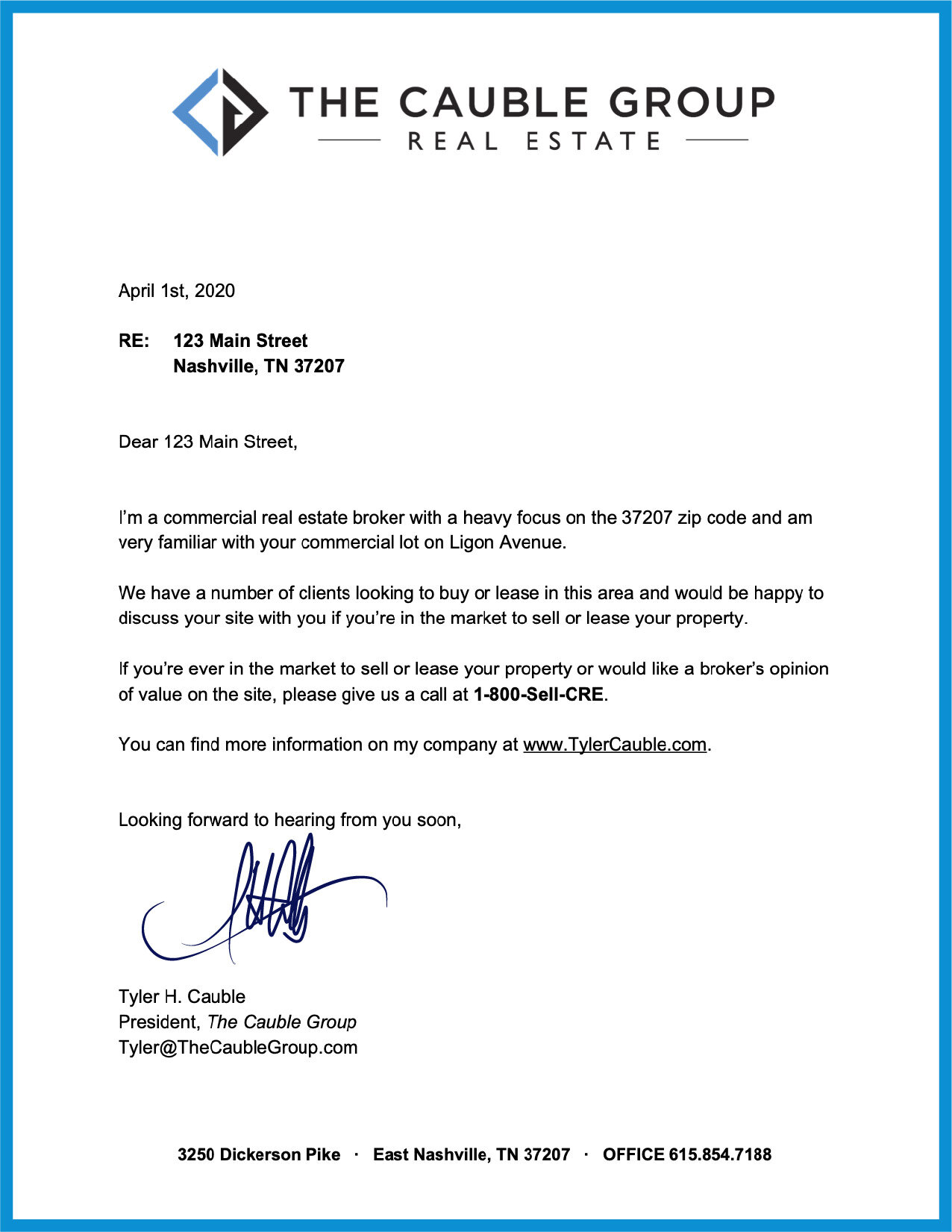Direct Mail for Commercial Real Estate
Sourcing Off-Market Real Estate Investments
In August of 2020, I bought a neighborhood retail building in Nashville for $435,000 that, after we leased it out, will bring me a 30.85% cash on cash return in year 1.
Today I'm going to show you how I sourced that building and that investment opportunity through a direct mail campaign and how you can do the exact same thing.
First, What Is Direct Mail?
Direct mail is one of the methods that I recommend you use to find off market commercial properties.
If you're on the hunt for your next investment, it's when you send a letter directly to the owner of the property in order to see if they're willing to sell the site.
Now, there are several different ways that you can actually do direct mail:
postcards,
handwritten notes, or
letters that you actually sign and hand-address
The most effective and efficient method that I've found is to actually type up these letters, sign your name, and then hand address on the envelope - they tend to get the best open rates.
When the pandemic first hit, my team and I dialed in on the amount of direct mailers that we were sending to property owners in our area. Since the calls stopped coming through the doors at our commercial real estate brokerage, we decided we had to take action and go out and find the deals ourselves.
So each member of the team actually committed to sending 10 letters per day to property owners in the neighborhood that we had chosen, which happened to be East Nashville.
That’s how I wound up finding that 30.85% cash-on-cash investment opportunity.
Let me show you the exact method that I use to source that deal.
How to Send Direct Mailers to Commercial Property Owners
Put together a list of property owners
Scrub and consolidate owners with multiple properties
Send letters consistently each day
First, I pulled a list of commercial property owners in the neighborhood that I wanted to farm. In Nashville, we have the Metro Tax Maps, which has all of this information - you could also use a program like CRS Data to source those leads.
I then downloaded that list into a spreadsheet and consolidated it by property owner entity and mailing address. By doing so, I didn't send any single investor the same letter twice.
Next, each member on the team committed to sending at least 10 letters per day until we reached the end of the list. Why 10? Well, there are only so many phone calls that one could reasonably answer and properly work. If we dropped hundreds or thousands at once, we may get inundated with phone calls and miss a lead.
At that point, we just went on repeat and started back at the top of the list sending new letters to that same group in order to maximize the amount of touches with each owner.
It often takes 7 to 12 letters before you get a response, so don’t be discouraged if you haven’t heard back on the first few.
Sample Direct Mail Letter for Commercial Real Estate
Okay, so now that you know the method that I use to source these deals through direct mail, let me show you the exact letter that I was sending.
So, you can see the letter we used is pretty straightforward.
At the top here, I actually have an address regarding the property that I'm reaching out about - if there were multiple sites that fell under this ownership entity or to this mailing address, I made sure to point out the various addresses here.
You'll note, too, that I also opened it up with “Dear [property ownership entity].” In commercial real estate, it's rare that you'll come across a piece of property that is owned directly in somebody's name. Typically, investors will own it in some sort of entity like an LLC, a corporation, or a partnership. So, instead of trying to dig in and take all that time to find out exactly the right person to whom I should address the letter, I just addressed it directly to that entity.
Since I own a commercial real estate brokerage, I wanted to open up with the fact of who I am and exactly what we're looking to do. We were farming a very specific area (you'll note the 37207 zip code), so I specified that in the letter so that this property owner knew that I was intentionally sending it to them and it wasn't just another spam piece of mail.
In the second line there, you'll see that I somewhat reiterate what I say in the first line by telling them that we have clients that are looking to buy or sell commercial real estate in the area. On the next one, I tell them if they're looking to sell or lease their property, or just want a broker's opinion of value, which is a great way to get your toe in the door, they could reach out to me at any time.
Now at the very bottom of this letter is room for my signature. I make sure to hand sign each one of these letters with a blue pen every single time. Blue ink is far more difficult to “fake,” so it comes off as that much more genuine.
But that's it - I mean, the letter is pretty straightforward.
Nothing too complex about it. No crazy pitches or sales language in there. You see that my method is pretty straightforward. My team and I actually went through the steps and sent the letters, which I think that that's the biggest factor that a lot of prospectors do not realize or forget about. Sometimes, you just got to put that work in.
Now once I have signed this letter, I'll fold it up, put it into an envelope and I will hand address every. single. letter.
In my opinion, this step is the most crucial to having a successful direct mail campaign.
Think about it this way: when you get a letter in the mail that is hand addressed to you, the chances that you're going to open it significantly increase over something that has a sticker on it or is typed out on the envelope. And since very few pieces of mail are being sent nowadays, your letter is sure to stand out.
Will Mailers Work for Commercial Real Estate?
Absolutely.
One of the biggest reasons that I was able to get such a good deal on this property is that we sourced it off market - that's why I'm going to end up with a 30.85% cash-on-cash return year one because there were no commissions, no realtors fees, and the seller was ready to make a deal.
After negotiating everything with the seller, we put it under contract and I was able to source a tenant to lease the building before we closed. Commercial properties are valued based on the income that a lease would bring in and not just a price per square foot appraisal, which is one of the many reasons we choose commercial real estate over residential.
Instead of the appraiser coming in and looking at nearby comps on a square foot basis, they were able to apply a cap rate on the building and value it at several hundred thousand dollars more than what we were paying for it. We had built-in equity in the property and the bank didn't require us to bring as much money to the table, hence the great cash on cash return.
Had this property gone to market and we found ourselves in a bidding war with other buyers, I don’t think we could’ve gotten such a great deal. So, the mailers made all the difference.
Summary
So for a quick recap on direct mail:
pull a list off the tax records
be sure to scrub it and pull out any of the same owners or mailing addresses so you don't hit them twice with the same piece of mail
always hand-address every single envelope and commit to sending a certain amount per day
Okay, so now that you've sourced your property through a direct mail campaign, you've got to do your due diligence.
That's the next step in the process that can ensure whether or not you have a successful investment, so check out this next article below where I walk you step-by-step through my commercial real estate due diligence process, including a link to download my checklist, as well.
About The Author:
Tyler Cauble, Founder & President of The Cauble Group, is a commercial real estate broker and investor based in East Nashville. He’s the best selling author of Open for Business: The Insider’s Guide to Leasing Commercial Real Estate and has focused his career on serving commercial real estate investors as a board member for the Real Estate Investors of Nashville.





















Recessions expose the strengths and weaknesses of every investment portfolio—but in commercial real estate, some asset classes consistently rise above the volatility. While economic downturns often lead to higher vacancies, tighter lending conditions, and declining property values, not all sectors are equally vulnerable. In fact, a select group of asset classes tend to outperform, offering dependable cash flow and tenant stability even in uncertain times.
These recession-resistant properties share a few key traits: they serve essential needs, attract long-term tenants, and demonstrate historically low vacancy rates regardless of economic conditions. Whether you’re a seasoned investor rebalancing your portfolio or a new buyer looking for durable assets, understanding where to deploy capital in a recession is critical.
In this post, we’ll break down the top three commercial real estate sectors that offer resilience during downturns—industrial real estate, medical office buildings, and necessity-based retail. Each has its own strengths, challenges, and long-term outlook—but together, they represent a strong foundation for any investor looking to build a portfolio that can weather the next economic storm.
Let’s dive in.